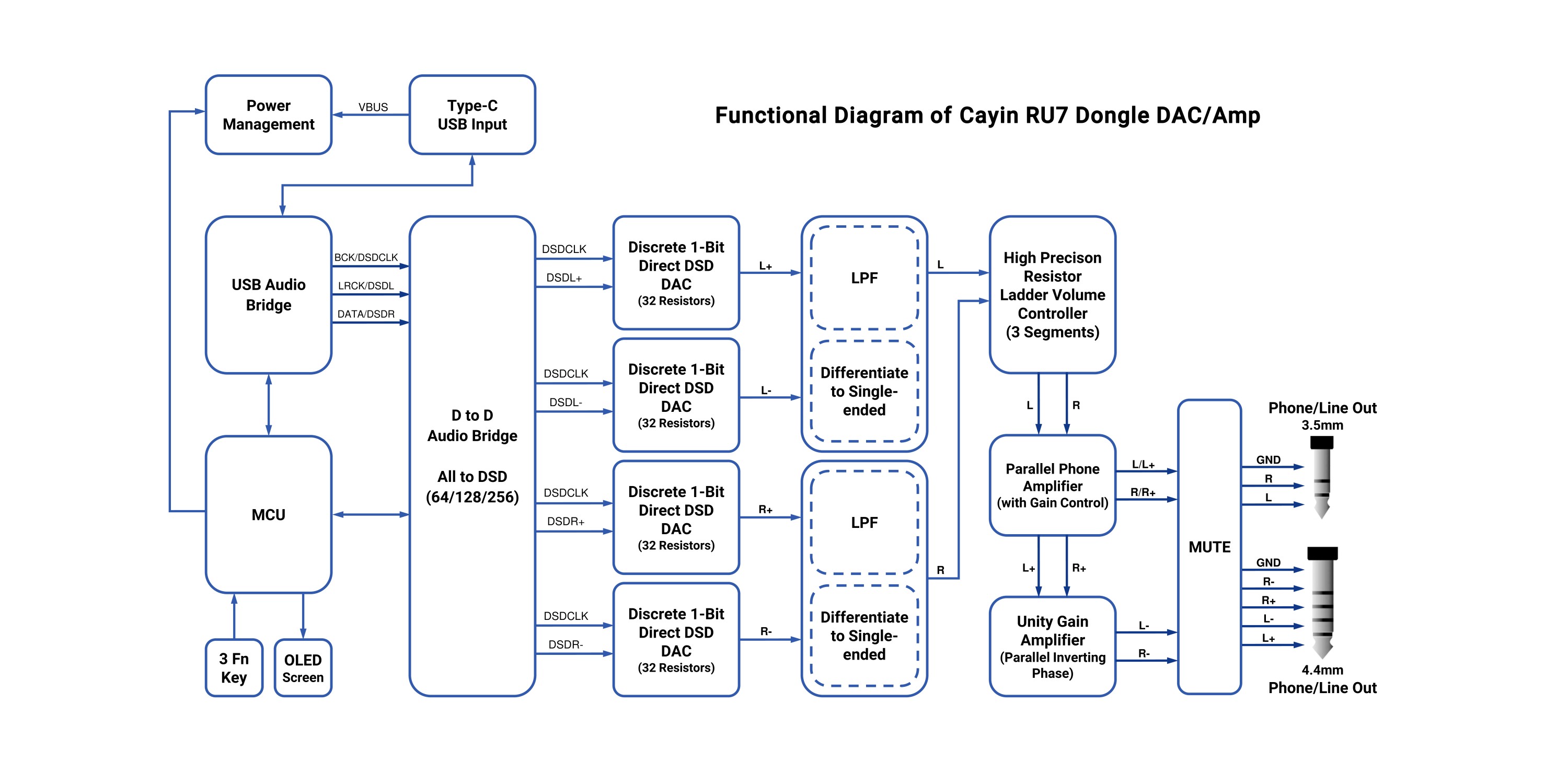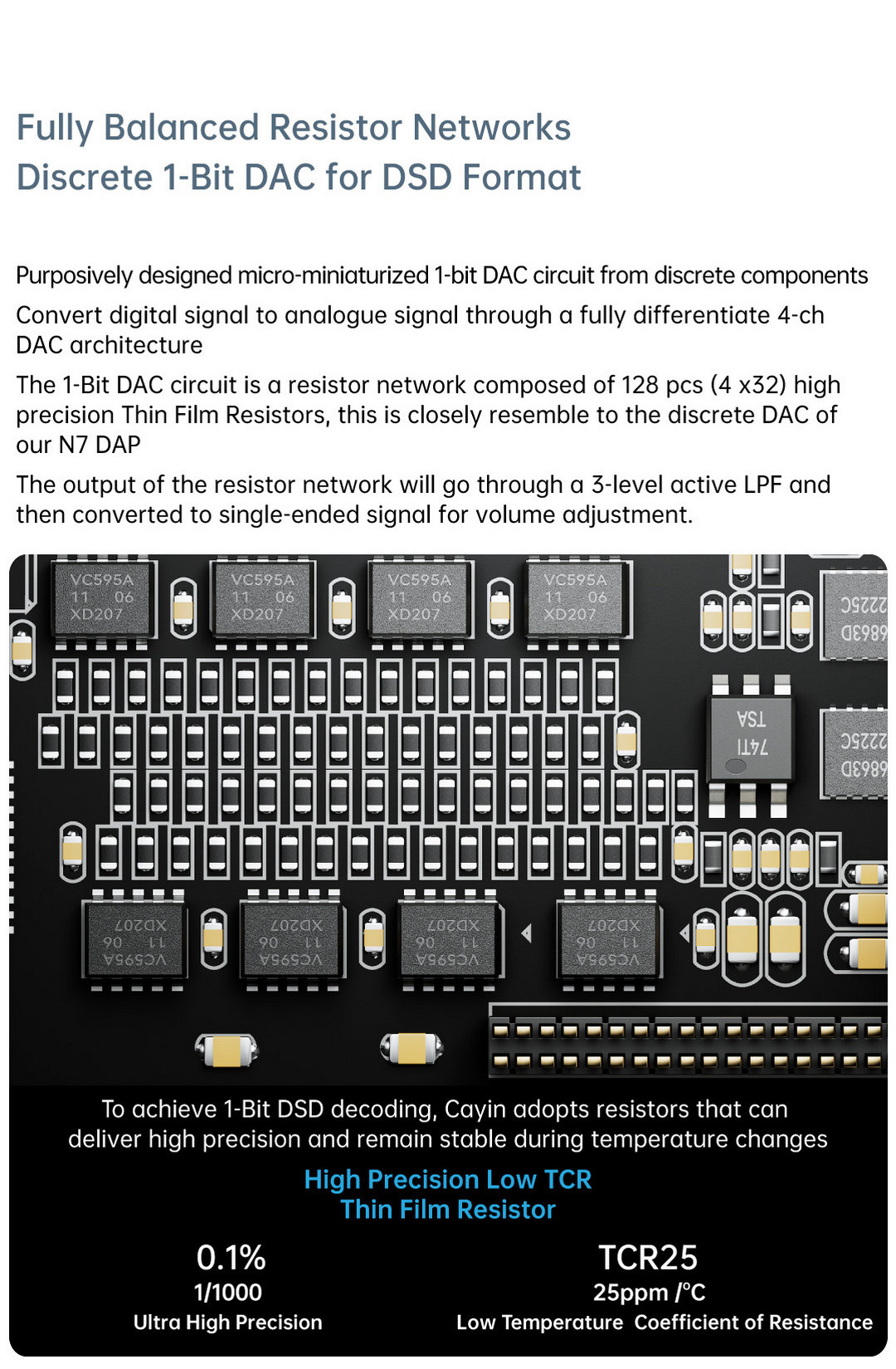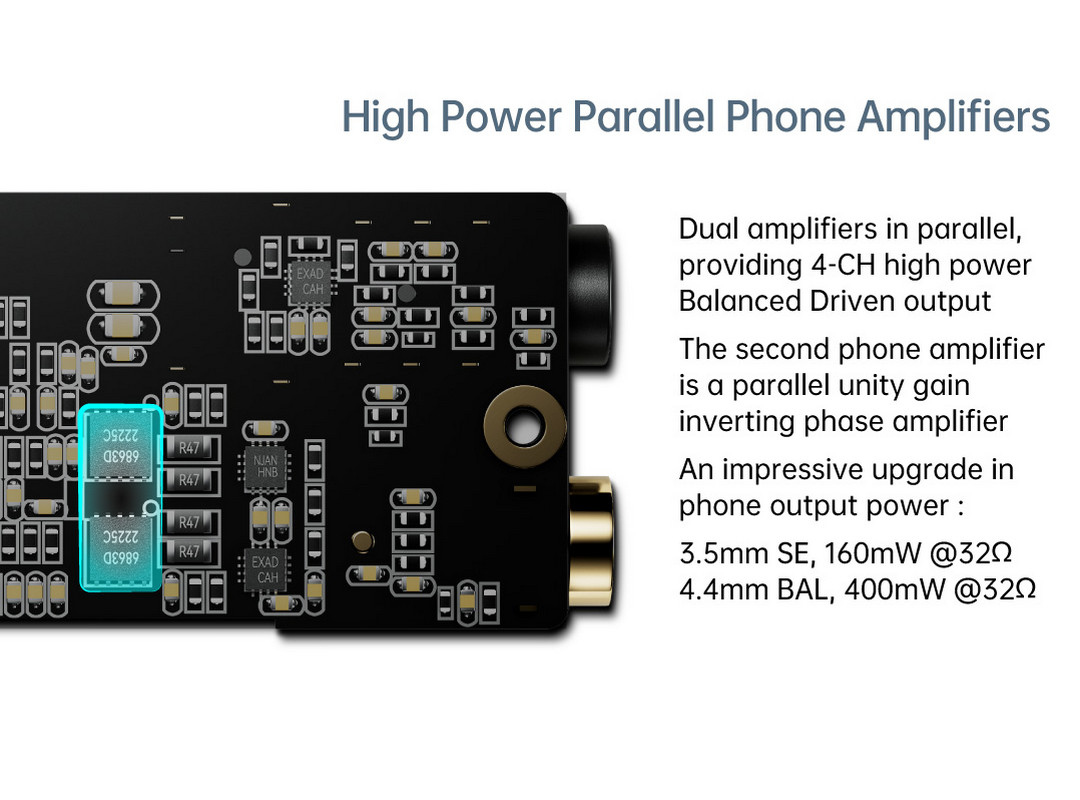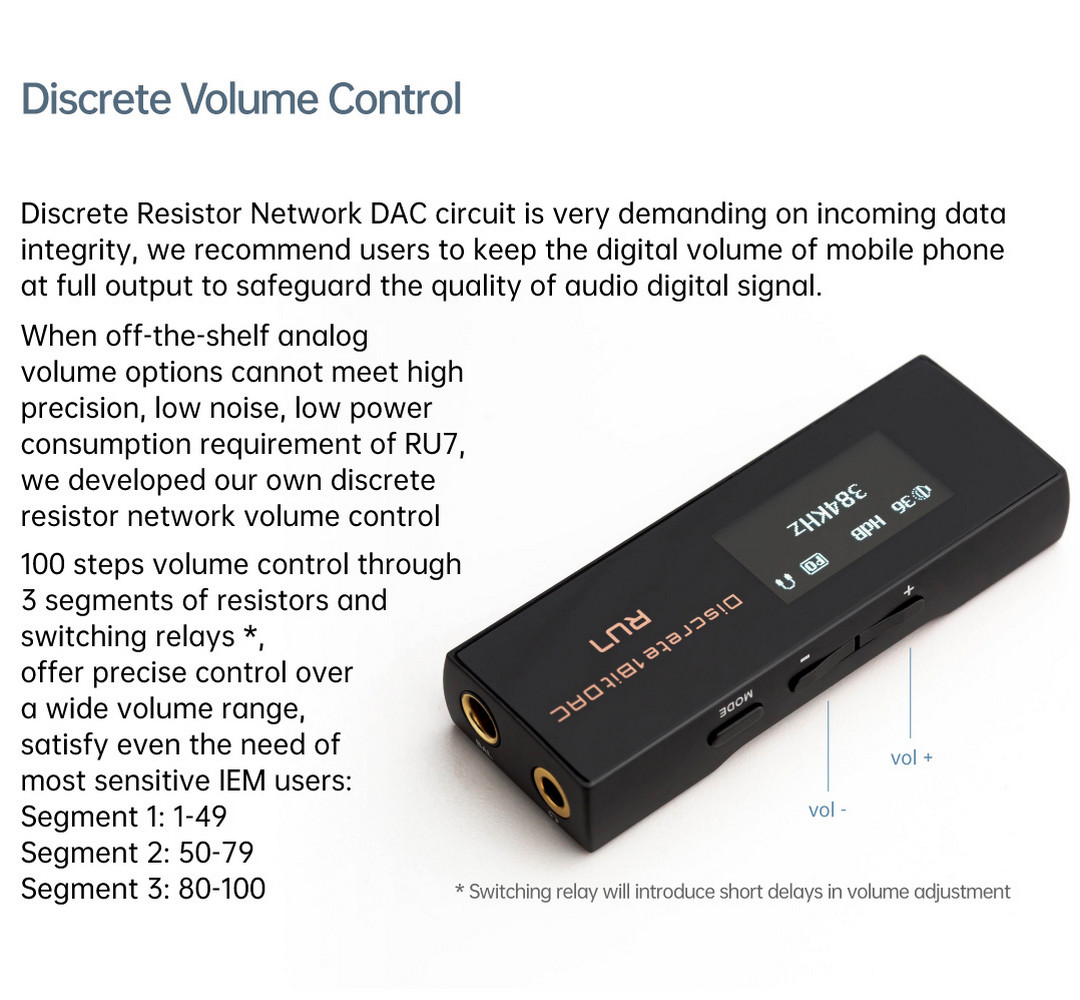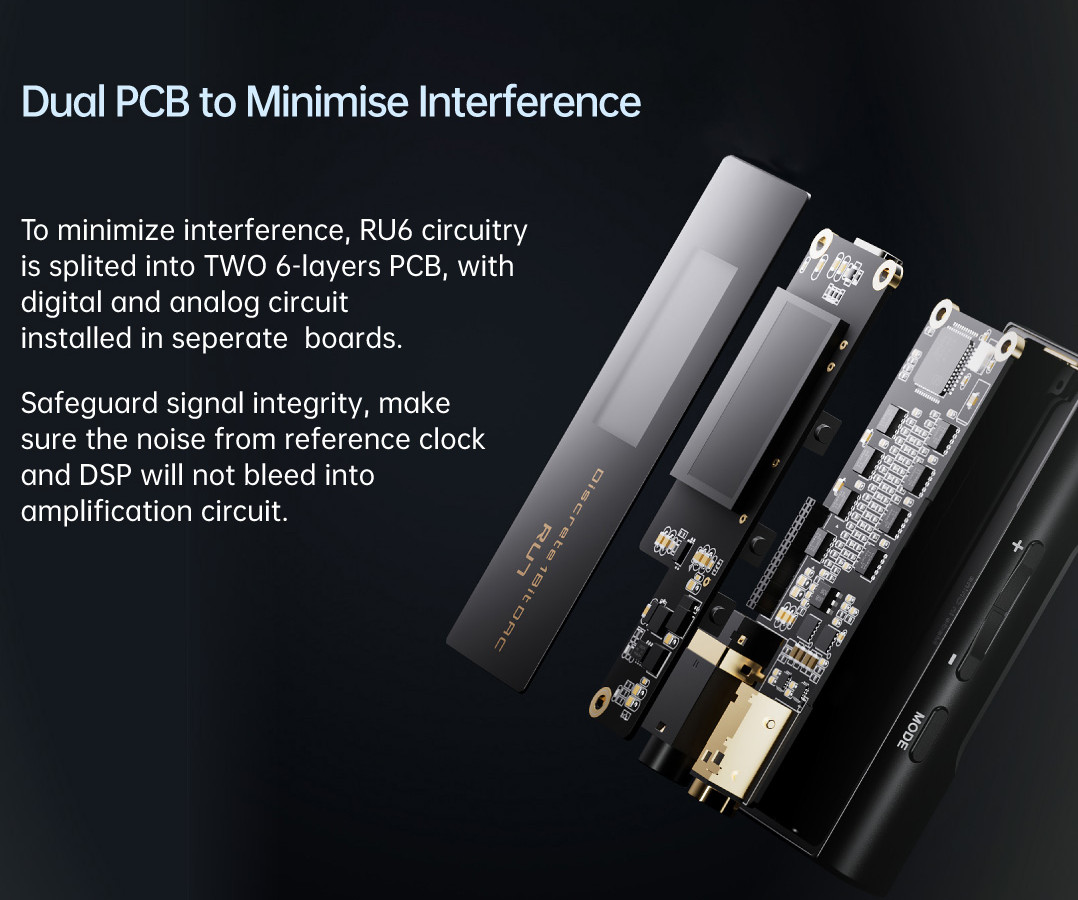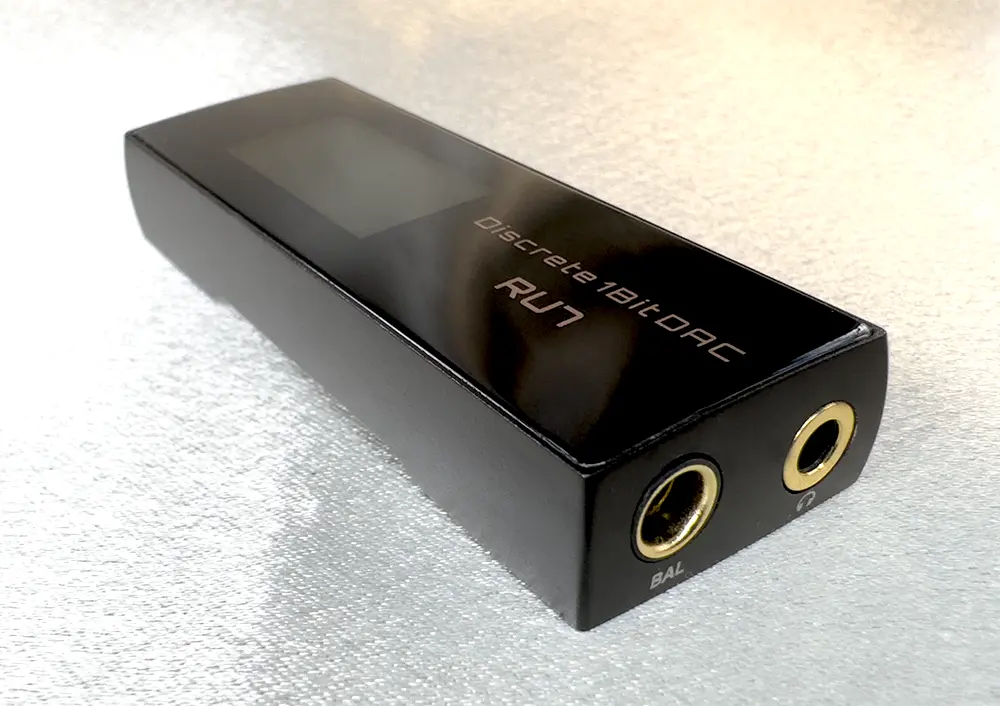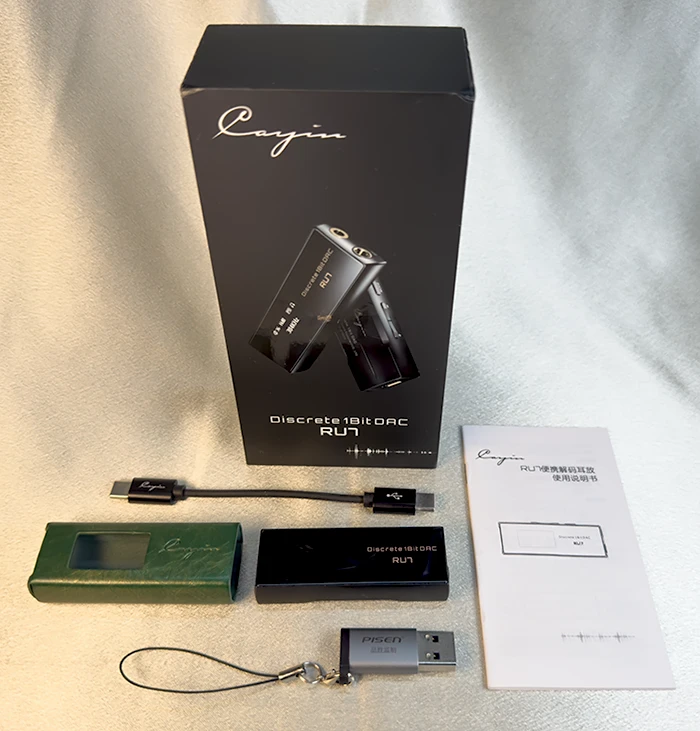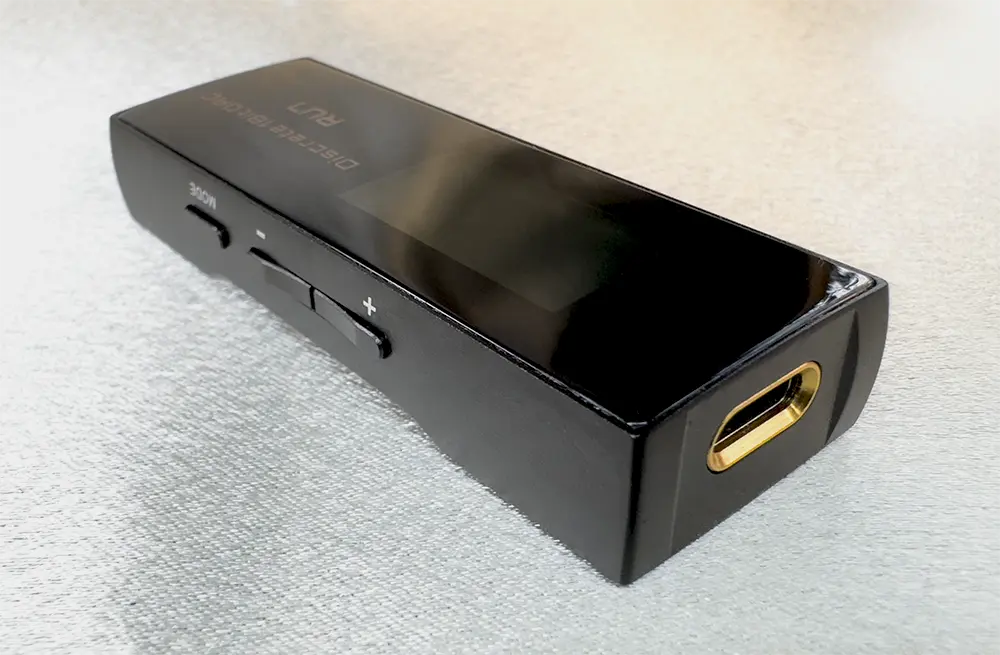Introduction: RU7 is the latest flagship dongle released by Cayin as a successor to their previous flagship, the Cayin RU6. While the RU6 features a 24-bit Discrete R-2R Resistor Ladder DAC, the RU7 uses 1-Bit Discrete Resistor Network DAC, a different type of technology trickle down from their flagship N7 DAP, instead. This dongle has a MSRP of 290$.
Disclaimer: I bought the Cayin RU7 with my own money. Everything i said in this review is my subjective opinion only.
Unboxing:
The box was quite smaller than i thought. It’s only as big as my Poco F3 phone.
Inside the box, we have a few things: The C-C OTG cable, C-A adapter, a green leather case, a user manual and 2 magnets (sadly i lost it)
The green case itself fit the RU7 very snuggly. I won’t need to worry about the case coming loose anytime soon, unlike some previously known cases of the RU6.
Design
The RU7 has a small rectangular form factor. Its chasis is made out of aluminum with a matte black finish and glass panel with a built-in OLED screen on top.
On the side is the 3 buttons, 2 of which let you controlled the volume and the “mode” button to control the settings of the RU7. Click the “mode” button once to turn the screen on/off. By holding it in a few seconds, it let me go into a setting menu. I can change between Low gain and high gain, switch between the 3 DSD modes and the output of the RU7 (Phoneout or Lineout).
User experience:
The Cayin RU7 is small, light weight, has a protective case so i dont have to worry about scratching. The setup was relatively smooth when i wanted to use my RU7 with Window 10 laptop. I just need to plug and play and that’s done.
With 2 levels of gain, 3DSD mode and 2 output types, the RU7 gives me a lot of flexibility on how i’d want to use it on a daily basis.
Overall, my time with the Cayin RU7 was quite enjoyable. However, it’s not without its quirks.
First thing i’d like to note is how much the Cayin RU7 battery consumption. It drains my Poco F3 faster compared to every dongle that i’ve own. It only took me more than 4 hours to drop my battery percentage from 100% to 0%. Not to mention that even without playing music, the RU7 keeps draining the battery of the phone.
The second thing i’d like to note is the clicky, zappy sounds while using the RU7. This sound is very different from the usual humming noise floor when i use my Ibasso DC04 Pro and 7hz 71 with a powered laptop. These audible noises appear when i’m switching songs, when fast forwarding music and worst of all, it’s even appeared during some quiet session of the songs or videos. This is due to the resistor working inside. Andy from Cayin has already commented about this on the Cayin RU7 thread, so this behaviour is normal to the RU7. Some can live with it, but honestly after i noticed this sounds, the existence of it is quite...annoying.
Last thing i want to talk it how much heat the RU7 generated during use, especially in DSD256 and LO mode. I don’t know the exact temperature, but i’m pretty sure it’s over 50 degree Celsius after 30 minutes of listening.
Sound impression:
I’d describe the sound of Cayin RU7 as neutral and analog sounding.
Bass has this more rounded and fullbody sound to it with very light midbass emphasize. You can say the RU7 sounds a bit warm to it due to this discription, but i’d still say the RU7 is on a neutral side of things.
Midrange wise, the RU7 just do it just right. Neither too forward nor backward. The midrange of RU7 just sounds natural as is.
Treble is detailed smooth with no digital glare. There’s a subtle lower treble boost in the RU7, in a way that it makes the percussion instruments’s attack just sound a bit more crisp.
Technicalities wise, RU7 is the most technical sounding i’ve heard. Only after 10s of using RU7 that i know this dongle is quite something else. The soundstage is really wide with clear imaging and layering.
For a more relative context of how RU7 performs compared to others, please continue reading for the comparison parts.
Synergy: RU7 can synergize with a lot of gears, but i don’t think it’s suitable for the overly colored or warm sounding sounds tranducer.
For people that want most fast sounding bass, highest detail, clearest, more hi-fi sound rather than analog sound, the RU7 would not be for them.
RU7 in LO mode: I want to test how the RU7 would sound in LO mode without having to use an additional amplifier, so i tested the LO mode directly with the TGXear Totem, since i think having an ỉmpedance of 700ohms would somewhat keep it safe and not making it too loud. After thorough testing, i think the the sound from LO mode is slightly better than PO mode. Compared to the PO mode, LO mode sounds like it has a better impact subbass and a bit more transparent.
Word of caution if people want to test LO mode with other more sensitive gear: If you’re using a laptop or PC, please lower the volume of the software you’re using to listen to music, not the OS themself. For some reason, even if i turn my laptop vol from 100 to 1, the loudness of LO mode remains the same. Only when i turn down the volume of foobar2000 app or youtube’s video that the volume did come down. Also, it seems like the RU7 does not let you change between the modes rapidly, where you’d need to wait around 10 secs for the mode to be changed again. (the screen may show that you’ve already changed the output mode, but you’d need to wait for 10 secs for it to take effect)
Differences between DSD64, DSD128, DSD256
Truth be told, it was really hard for me to do comparison for these 3, as i feel like the differences was too small between them. Switching between the modes for every 10-15 seconds of the same songs did not really help me. So in order to make this comparison, i have to listen to each mode for around a few days then switch to another. After thorough testing, here’s what i think about the 3 DSD modes.
DSD64: Slightly more warmth and full. More analog sounding
DSD128 Jack of all trade. Most balance sounding, loose a bit of detail for naturalness
DSD256: Highest detail and clarity. A bit more digital sounding
Driving power: The Cayin RU7 is no doubt a very powerful dongle. At high gain and 100/100 level, it can drive my Shuoer S12 to a deafening level of 90db. It can also drive my 700ohms of impedance TGXear Totem earbuds to a comfortably loud level (around 80-85db) without sacrificing much, if any, bass texture and overall dynamic, so power is definitely not an issue here
Sound comparison:
1/ Ibasso DC04 Pro
I know i know, the DC04 Pro is not really in the same realm as the Cayin RU7. Its price is not even half of the RU7. However, the DC04 Pro was one of the most famous dongle in 2023, ranking 1st in the Best bang for buck category by DongleMadness. Many people were able to afford this. It was also my previously EDC dongle, so comparing these 2 against each other is something i should do.
Both dongle in my opinion has a neutral and analog-ish tonality, but right of the bat, there’re 3 differences that i noticed: the bass, the treble and the imaging.
The bass has more thump and better texture to it, compared to the DC04 Pro. Using Penon Serial to test, the bass on the DC04 Pro feels like it got cut of at the end of the notes. Those “strings plucking” moments in some of my jazz tracks just feels a bit incompleted, whereas it sounds more completed on the RU7. The bass there feels more lifelike, i can virtually imagine the instruments being played
As for treble, i feel like the treble of the RU7 is crisper than the DC04 Pro. However, due to this right here, the synergy of the RU7 would be a little different from the DC04 Pro. Some iem that has too much treble would not be able to synergize well with the RU7, whereas the DC04 Pro would be a better option between the 2, cue the TGXears Serratus and Hifri’s Barcelona. The treble there just feel a bit more pronounce with shaper, crisper transient.
Imaging. Coming from the DC04 Pro to the RU7, my first thought was “man, has the layering always been this crisp and distinct?”. I thought i was being paranoid due to “new toy syndrome”, so i listen to RU7 for a while longer then switching back to the DC04 Pro, the sentiment was still the same. The Cayin RU7 sounds wider, with better instruments separation and a more distinct layering between the instruments compared to the DC04 Pro
That being said, the RU7 did not completely kill the DC04 Pro. The DC04 Pro has a better battery consumption rate, it drained my phone’s battery way less. Even without listening to music, RU7 drains the battery of my phone. The DC04 Pro also generate less heat. It doesn’t have that usual clicky, zappy sounds from the resistor of the RU7. On Android phones, there's an app from Ibasso that let you adjust some settings of the DC04 Pro. Another thing i’d like to note is the noise floor when using the RU7 with my plugged in laptop is virtually zero, compared to a small amount of noise when using with the DC04 Pro. Although in my opinion, that would just like changing from another devil to another: The humming noise (due to the plugged in laptop) of the DC04 Pro vs the clicky sound of RU7 in those silent moments like during songs transition.
Is the Cayin RU7 an upgrade to the Ibasso DC04 Pro? In a sense, yes. It improves upon many things of the Ibasso DC04 Pro like the overall tone and the technicalites, despite it already is a good dongle in and of itself. If you’re looking for a do-it-all, only-keep-one dongle, then yes, buy the RU7 as an upgrade to the DC04 Pro. Is it worth it? Depend on your wallet. But if you already have the DC04 Pro and you’re looking for a dongle to diversify your dac/amp collection, i’d advise you to look for something else like the Cayin RU6 or the Hiby FC6 and keep the DC04 Pro. Despite me describing the differenes of these 2 for this long, the DC04 Pro is more similar to the Cayin RU7 than they are different. Both have i’d call a neutral and analog sounding.
2/ Chord Mojo.
Now i’ll reverse the scenario. Here i’ll compare the the Cayin RU7 against something that has more than double the msrp of it: The Chord Mojo. It was sold for 599$ the moment of its release. The reason why i’m picking the Mojo is that the Mojo are being sold in a very competitive pricing in the 2nd hand market (around 150$-160$ in Vietnam and Chinese), so good sound is very affordable there. The Mojo was arguably one of, if not the best sounding dac/amp during its time.
So here, we’d have a battle between the top of the dongle world in 2023, against the previous top of the portable dac/amp world in 2015. New vs old, how would they fair against another?
Both of these are wildly different. The Mojo has a battery and the RU7 does not. The Mojo has a custom FPGA DAC technology, whereas the RU7 has a 1-bit DAC technology. The Mojo has 2 3.5 phoneout ports rather than a 3.5mm SE and a 4.4mm balance of the RU7. Despite being SE only, Chord Mojo has more power to tap into compared to the RU7.
The differences in sound reproduction between the 2 were immediately perceiveable. Compared to the more neutral sounding RU7, the Mojo definitely has a more colored sounding. It’s more “romantic” in a sense. It’s warm, but also analytical.
Using the Penon Serial to listen to these 2, i definitely like the sound of the Mojo more. The Serial has a better bass texture, with more depth to its sound. The treble is also softer, yet the detail was around the same level. Imaging, i would hand it to the crisper imaging of the RU7. The Cayin RU7 has a touch wider soundstage compared to the Mojo. Synergy wise, i like to use the Serial on the Mojo more despite the Serial already warm sounding. The Serial just sounds more musical to my ear in this combo. Part of it was also due to me being a mild basshead.
Using the TGXear buds, the story was still the same. The Chord Mojo also colored the whole sound of the earbuds. The Serratus has a more natural bass tone with a better treble decay. The Totem was sort of brought to life more when pairing with the Chord Mojo. The Totem has a 700ohms Berylium driver which just screams for power, which the Mojo has. The neutral, reference-ness of Totem just synergize well with a more colorful and romantic sounding Mojo.
The Sunniva on the other hand. Sunniva is the one that the RU7 synergize well with due to the Sunniva already warm and thick sounding. The Sunniva sounds more balance, the treble becomes crisper with better imaging and layering when using with the RU7.
All in all, it’s all depends on taste. Personally, since i’d rather my music to be more musical and colorful and because i have many more colored sounding iem and earbuds (as opposed to a more neutral set like the Etymotic’s), i’d pick the Chord Mojo over the Cayin RU7 in many cases, despite its cons like the using of micro usb, 3.5mm port only and i have to charge it to use it.
3/ Cayin RU6
Brother from the same mother, the Cayin RU6. The Cayin RU6 uses an R-2R DAC technology inside its body. It’s been a while since i last used it, but judging from memory, the RU6 also has an analog type of sounding, however it feels warmer compared to the RU7. The bass on the RU7 has more authority compared to a more soft sounding bass on the RU6. Midrange and vocal wise, the RU6 is better than the RU7 in my opinion. I’d describe the RU6’s midrange and vocal as romantic, emotional and velvety. The RU6 used to be my go to dongle when ever i want to listen to some lyrical music or when i just want to vibe with the music, not analyzed it. Treble sounds crisper and shaper on the RU7. Techinicalities wise, especially the soundstage, the RU7 is definitely better than the RU6. The RU7 has more details, wider sense of stage and a more distinct imaging. Synergy wise, i’d say the RU7 is easier to synergize with a lot of stuff more than the RU6.
Conclusion:
With the price of 290$, is Cayin RU7 worthy of its price?
Yes
The Cayin RU7 is one heck of a beast. It has become a benchmark in the dongle world, where future to-be-released flagship dongle would surely be compared against this. The RU7 gives people to have a chance to try what a 1-bit DAC would sounds like without hurting their wallet too much. The form factor maybe small, but what it brings to the table is not. Despite some of it quirks, being a neutral, analog sounding dongle with an impressive technicality, i’m confident that many people will like this powerful dongle if they can get their hands on it.
That’s it for my review and thank you for reading.



